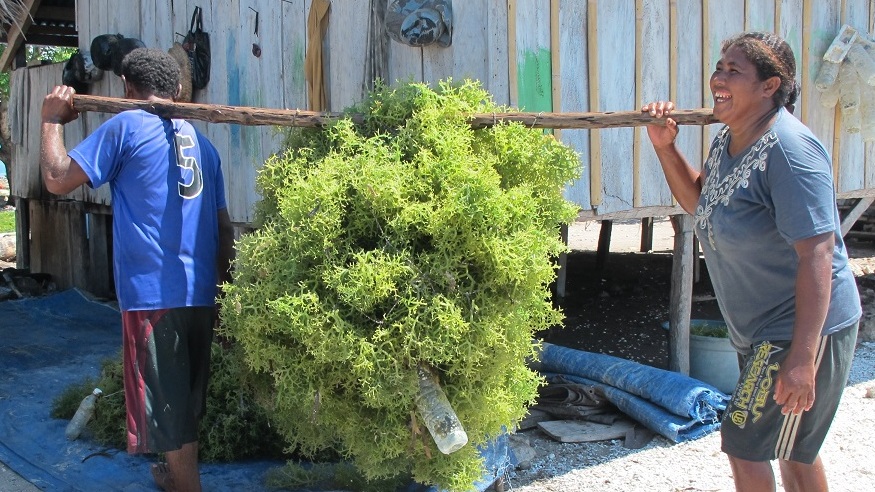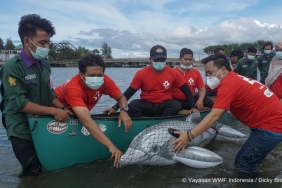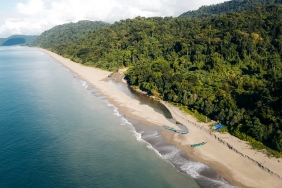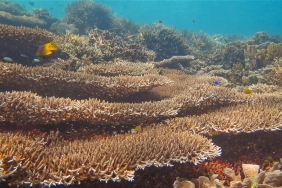SEAWEED CULTIVATION CLASS FROM UNHAS LECTURERS FOR TAKALAR FARMERS
By: Amriana, Local Facilitator of AIP Gracilaria Cultivation, Takalar.
Remember the Samaturu'e Group? Yes, Samaturu'e - which means 'struggling together'in the local language, is a group of Gracilaria seaweed farmers assisted by WWF-Indonesia and Celebes Seaweed Group (CSG) in Takalar.
After two months of being inaugurated, that day (10/09/17), seaweed farmers from the group were seen attending community service activities from the head and ranks of lecturers of the Aquaculture study program (BDP) of the Faculty of Marine Science and Fisheries (FIKP) Hasanuddin University (Unhas).
In collaboration with WWF-Indonesia and CSG, this activity took place in Ling. Cilallang, Takalar Village, Mappakasunggu District, Takalar Regency.
"In the future, it is hoped that there will be pilot farms that implement Better Management Practices (BMP) Seaweed from WWF-Indonesia. But before achieving that, the group members expect input from all parties including lecturers, from academia," said Idham Malik, Aquaculture Officer, WWF-Indonesia.
Syaifuddin Caco, head of the Samaturu'e Group, welcomed the fifteen BDP Unhas lecturers who attended that day. The purpose of this activity was indeed to exchange information to find solutions to the problems faced in the cultivation of Gracilaria seaweed.
"Indeed, the condition of Gracilaria in Mappakasunggu in general, only in July-August showed good seaweed conditions," said Dr. Ir. Rustam, M.Sc, a lecturer in Aquaculture at Hasanuddin University.
"The main problems seen in Gracilaria cultivation show that the average water temperature is quite high, the condition of the seaweed has broken branches and pigment damage, and is stunted due to lack of nitrate and phosphate elements," he continued.
The condition of living things that are cultivated will represent the condition of the environment. So, farmers must be observant to see significant changes in seaweed.
For example, when the seaweed turns black, it already shows that the bottom of the pond has an increased concentration of organic matter and ammoniacal substances, and has a low pH. This is where the pond needs to be rested by draining the pond and dredging the sludge.
Not only draining the ponds, but it is also necessary to remove the sludge to increase the alkalinity of the soil pH; washing the ponds from ammonia; and liming the ponds to increase the pH of the soil.
That day, farmers learned how to overcome this in the Good Fish Cultivation Practice (CBIB). They understand that pond preparation is a supporting factor for optimal seaweed production later.
"Processing or preparation of ponds before stocking seeds, the use of quality seeds, the application of technology to maintain water quality conditions to support seaweed growth, fertilization gradually with the appropriate dose, is our "homework" together with the cultivators," said Idham Malik summarizing the results of the discussion that day.
In addition, this activity also concluded the need for supervision from the cultivation process to post-harvest by applying good cultivation methods, and the need to plant mangroves in the pond area to maintain good environmental conditions with a balanced ecosystem.
This activity, as it turned out, also produced other results. Two days later, on 12/09/2017, a follow-up meeting agreed on a commitment to assist six interested farmers to conduct total draining, liming, and washing of ponds, as well as planting of mangroves in waterways and on the edge of bunds.
The good news is that the drying process and the planting of mangroves will be done together, utilizing shared resources. Of course, for better quality seaweed production from the Samaturu'e Group in Mappakasunggu, Takalar.





